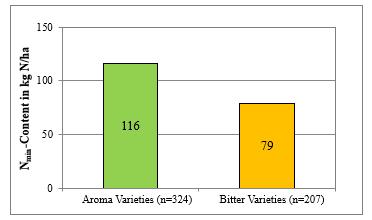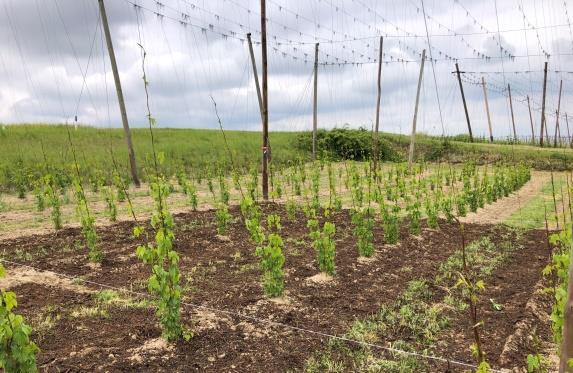
4 minute read
optimize the nutrient efficiency of organically bound nitrogen (ID 6141
Comparing the Nmin content in terms of different hop variety grown at the same sampling site, aroma varieties have significantly higher average Nmin levels than do bitter varieties (Figure 4.9).
Figure 4.9: Nmin values taken on 9 sampling dates by hop varieties (2018-2020)
4.4 Experiments with composting and recycling of shredded hop bines to optimize the nutrient efficiency of organically bound nitrogen (ID 6141)
Sponsor: Bayerische Landesanstalt für Landwirtschaft, Institut für Pflanzenbau und Pflanzenzüchtung, AG Hopfenbau, Produktionstechnik (IPZ 5a) [Bavarian State Research Center for Agriculture, Institute for Plant Production and Plant Breeding, AG Hop Production, Production Technology (IPZ 5a)] Financing: Erzeugergemeinschaft HVG e. G. (HVG Hop Producer Group) Project Management: J. Portner Team: A. Schlagenhaufer, J. Stampfl, S. Fuß Collaboration: Prof. Dr. Meinken, Institut für Gartenbau, (Horticultural Research Institute) Hochschule Weihenstephan-Triesdorf (HSWT) Prof. Dr. Ebertseder, Fakultät Nachhaltige Agrar- und Energiesysteme, (Faculty of Sustainable Agriculture and Energy Systems) Hochschule Weihenstephan-Triesdorf (HSWT) M. Stadler, Fachzentrum Agrarökologie, (Centre of Expertise for Agroecology), AELF Pfaffenhofen Duration: September 1, 2018 to February 28, 2022
In the Hallertau hop-growing region, 880 farms cultivate 17,233 ha of hops and produce a total of roughly 230,000 MT of shredded bines each year. Around 80% of this plant matter is currently being returned to the fields as fertilizer. These bines, however, contain substantial amounts of nitrogen. With the implementation of the new Fertilizer Ordinance, a farmer is required to use the nitrogen contained in the shredded bines as efficiently as possible and to avoid N-dispersion into other ecosystems. To meet these requirements, extensive composting and field trials with shredded hop bines will be conducted over three years.
Objectives
• Risk assessment of increased nitrate leaching as a result of the application of shredded hop bines in the fall in accordance with current practice • Development of environmentally compatible and practicable composting processes for shredded hop bines • Investigation of the nitrogen effects of the various composts/substrates in field trials • Comparison of the different processes with regard to economy, ecology, and practicality • Reduction of nitrogen losses in shredded bines • Legally compliant, practical, and environmentally friendly recycling of the shredded bines with optimal use of the organically bound nitrogen
Method
The experimental setup of the project is divided into four “work packages” (AP 1 to 4): The experiment is based on composting tests (AP 1), to develop the basic conditions for aerobic composting on a small scale (size approx. 1.5 m³). At the same time, in a further experiment, after the harvest, shredded bine material is simply stored aerobically and composted or siloed (AP 2) using the Witte method (MC composting). This composting trial under practical conditions has several objectives. On the one hand, the knowledge gained under small-scale conditions should be verified for its real-world practical applicability. Also, aerobic composting should be compared to the three other trial variations with regard to the practicality and the conservation potential for the nitrogen present in the shredded hop bines. Furthermore, these trials produce the material for plot tests to determine the N-efficiency of the four materials (stored shredded hop bines, aerobic and MC compost, silage), which form the third project part (AP 3). The material for the fourth part of the project, that is, practical experiments to determine N-dynamics in hop gardens (AP 4), also stems from these tests. All four sub-projects were started at the same time after the hop harvest in the fall of 2018. In addition, in 2017, as part of a bachelor's thesis, vascular tests with shredded bines were conducted. These will be continued as part of this project.


Aerobic Compost MC Process Silage Classic Storage

Application of the generated substrates as organic fertilizer on field tests and vascular tests


Figure 4.10 Representation of the experimental scheme: Above: AP 2, practical composting experiment Bottom left: AP 4, field trial with hops, shredded bines applied in May Below right: AP 3, plot tests with shredded bines
Results
Composting Tests In 2018, after the shredded bines had been stored according to current practice for no more than 4 weeks, dry matter losses were around 20% and nitrogen losses, just under 10%, mainly because of gaseous losses. As expected, there were no such losses in the silage. With the two composting processes, loss rates increased in a near-linear fashion with longer storage times. Field trials During the initial trial years 2018/19 and 2019/2020, there was no increase in nitrogen mineralization from the shredded bines between the fall, when they were placed outside, and the beginning of the vegetation period. This suggests that this organic fertilizer has a low mineralization potential. Similar findings could be obtained in vascular tests. This mineralization behavior suggests that the timing for placing shredded bines outside in the fall has no effect on the risk of nitrate leaching into the groundwater. The fertilizing effect of chopped hop vines could be determined based on nitrogen uptakes at harvest time, as well as in field trials with hops. In the field trials, the N-depletion of plots









